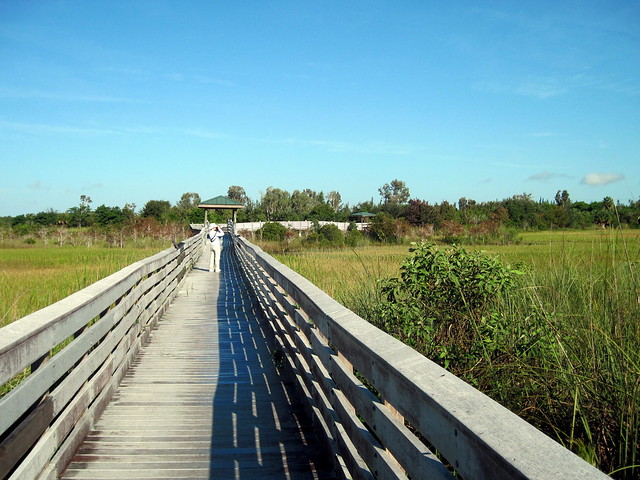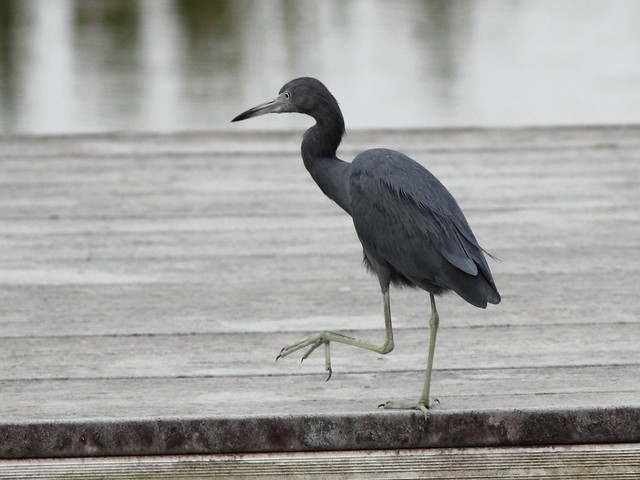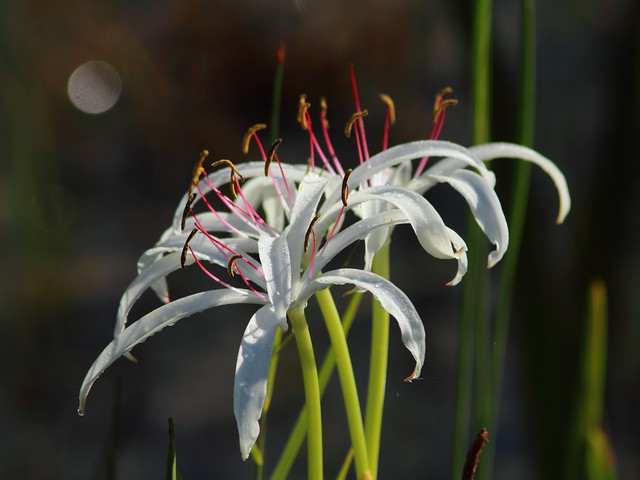Posted by: Ken @ 6:25 am
In an earlier post I described the creation of Chapel Trail Nature Center and its near destruction when vandals set the boardwalk on fire shortly before its planned grand opening. It had been open less than a year when Hurricane Wilma toppled most of the boardwalk. Earlier this month, soon after we returned to Florida from our second home in Illinois, we visited the preserve, located nearby in Pembroke Pines. It was a rather dull morning for birding. There had been plenty of rain, and flood water had diluted out the fish so that the long-legged waders were no longer concentrated there. We started out late and it became progressively more hot and muggy.
The resident Sandhill Crane greeted us at the parking lot…
…and posed next to a fire hydrant…
..but otherwise it seemed that the paraglider overhead and the insects and flowers around us would be the best sightings of the day: 
Spiny Orb Weaver:

This photo was marred by a single bokeh that took on the appearance of a full moon, but I decided that it looked in balance with the image of the Swamp Lily:
There were two of these little green-eyed blue-bodied black-tipped dragonflies. about 1 to 1 1/4 inch long– too small to be Eastern Pondhawks, so I at first was not sure of their ID. There is a midge on this one’s back. Interestingly, one species of dragonfly, Sympetrum, has antibodies against its midge parasite (Arrenurus planus). When the midge bites into the dragonfly, its piercing mouth parts turn bubble-like and the parasite dies. Midges are used to control certain insect pests (Reference).
Blue Dasher– look closely to see the midge, or click on the photo to see the note: 
A Green Darner rarely perches. This guy would not stop flying, but did hover in place long enough for me to get the center point focus on him. If I had planned this shot I would have increased shutter speed greatly:
The resident Red-shouldered Hawk watched us from it perch in a small tree:
A lone White Ibis flew overhead…
…as did an Osprey:
From the boardwalk, Mary Lou scanned the wetlands :
A Great Egret was nicely back-lit by the early morning sun:
A Green Heron stood on the rail of floating boat dock at the far end of the boardwalk:
Then, the head of a Limpkin appeared above the marsh vegetation (I did not notice the two Purple Swamphens, out of focus behind it and to the right):
The bird flew up and passed directly in front of us on the way to a roost in the small island:
Purple Swamphens seem to get more numerous every week at Chapel Trail. As we walked along the boardwalk, there were 2 to 3 in view at all times. We saw no gallinules or moorhens, which is a bit disturbing– their young are said to be food items for the invasive introduced swamphen:
We also saw a half dozen Eastern Kingbirds:
Many of the Eastern Towhees that breed in far southern Florida have yellow rather than red eyes:
A Common Yellowthroat foraged in the Red Maple leaves, already starting to change color:
The yellowthroat was joined by a Prairie Warbler:
Yesterday morning we got out just before a big rainstorm curtailed our walk. The leaves of the Red Maples had already gone from red to brown. We found that Palm Warblers had arrived in good numbers. They become so numerous during the winter that locals call them “Florida Sparrows.” During fall migration, the brightly colored eastern Yellow Palm Warblers cross paths with the dull western form, and winter more to the west, from northern Florida into east Texas.
This is a representative of the dull Western race, much more commonly seen than the bright eastern form:

Despite the dark skies, this Boat-tailed Grackle’s iridescent coat reflected many hues of blue:

It was starting to drizzle as a Mottled Duck flew overhead:
On the way out, I stopped to photograph a Little Blue Heron that was walking along the canoe dock:
A Marsh Rabbit watched us warily as we exited the boardwalk.. This semi-aquatic race of Cottontail has a darker coat and very short ears:

























